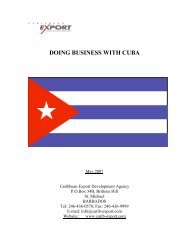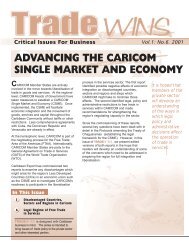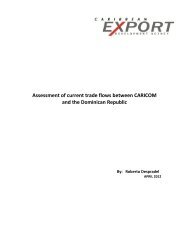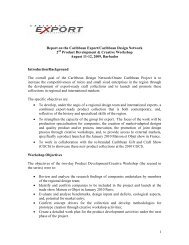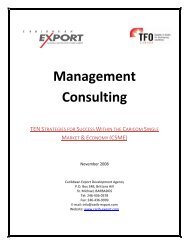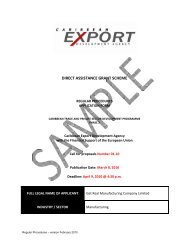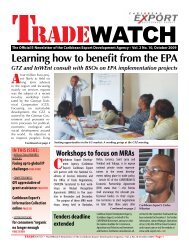The Furniture Manufacturing Industry of Barbados - Caribbean ...
The Furniture Manufacturing Industry of Barbados - Caribbean ...
The Furniture Manufacturing Industry of Barbados - Caribbean ...
You also want an ePaper? Increase the reach of your titles
YUMPU automatically turns print PDFs into web optimized ePapers that Google loves.
4.5 Production<br />
4.5.1 Sourcing <strong>of</strong> the raw material<br />
Species<br />
By tradition, “Barbadian Vernacular” furniture has mostly been crafted out <strong>of</strong> local mahogany<br />
wood. When freshly cut, the mahogany native to <strong>Barbados</strong> can be reddish, pinkish, or<br />
salmon coloured. It turns to a deep rich red or reddish brown as the wood matures with age.<br />
Mahogany has a fine to medium texture, with uniform to interlocking grain, ranging from<br />
straight to wavy or curly. Irregularities in the<br />
grain <strong>of</strong>ten produce highly attractive figures<br />
such as “fiddleback” or “mottle”. Mahogany<br />
polishes to a high lustre. Joiners appreciate it<br />
for its excellent working and finishing characteristics;<br />
experienced joiners say it is “sweet to<br />
work”, i.e. it responds well to hand and<br />
machine tools, has good nailing and screwing<br />
properties. It also turns and carves superbly.<br />
Mahogany is regarded as <strong>Barbados</strong>’s premier wood for fine cabinetry, high-class furniture,<br />
trimming fine boats, pianos and other musical instruments, sculpture, joinery, turnery, figured<br />
and decorative veneer, interior trim, and carving.<br />
It is to be noted that traditional craftsmen were far from using only mahogany even when<br />
producing fine pieces <strong>of</strong> furniture. Superb pieces that can be found in the workshops <strong>of</strong> longestablished<br />
workshops are <strong>of</strong>ten made <strong>of</strong> pine with an upper layer <strong>of</strong> mahogany veneer; only<br />
the more prominent/exposed parts <strong>of</strong> the furniture will be made <strong>of</strong> solid mahogany.<br />
While mahogany used to be abundant in <strong>Barbados</strong> little remains <strong>of</strong> the local mahogany resources<br />
today. Only occasionally are trunks available when a tree is felled on private premises<br />
for construction for instance. As an endangered plant, mahogany is a CITES II listed species,<br />
its international trade is thus restricted (<strong>Caribbean</strong> mahogany was listed in Appendix II<br />
in, 1992; the listing includes logs, sawn wood, and veneer sheets). <strong>The</strong> listings requires a socalled<br />
non-detriment finding and export permit by the exporting party.<br />
Drying<br />
Joiners have therefore turned to other tropical hardwoods (rosewood, various woods imported<br />
from South America) and to s<strong>of</strong>t pine wood as substitutes.<br />
Timber is generally sold “air dry”. For export furniture drying the timber becomes a key issue.<br />
To prevent movement in wood once it is being used in the centrally-heated and dry environment<br />
<strong>of</strong> US and European homes wood needs to be dried under controlled conditions.<br />
This ensures that gross dimensional changes through shrinkage are confined to the drying<br />
process. Ideally, wood is dried to that equilibrium moisture content that will later (in service)<br />
be attained by the wood. This will keep further dimensional change to a minimum.




